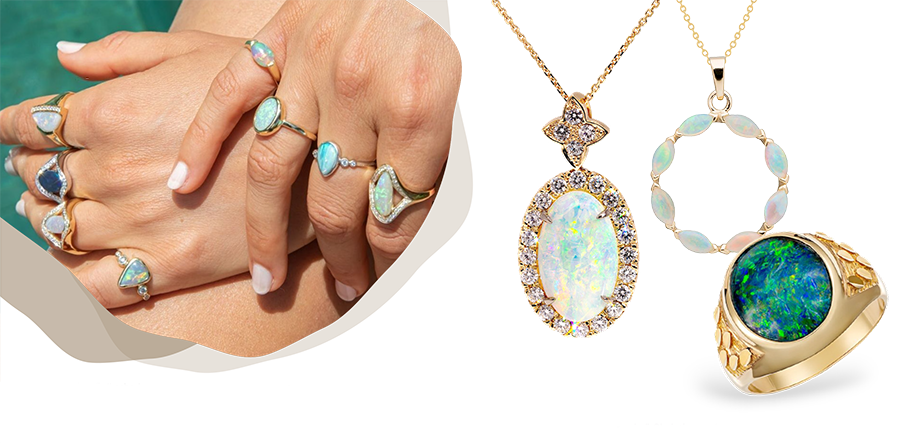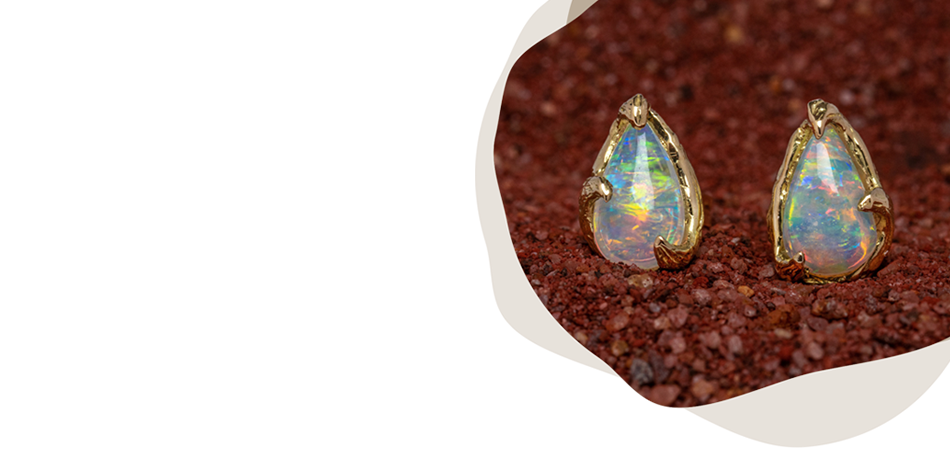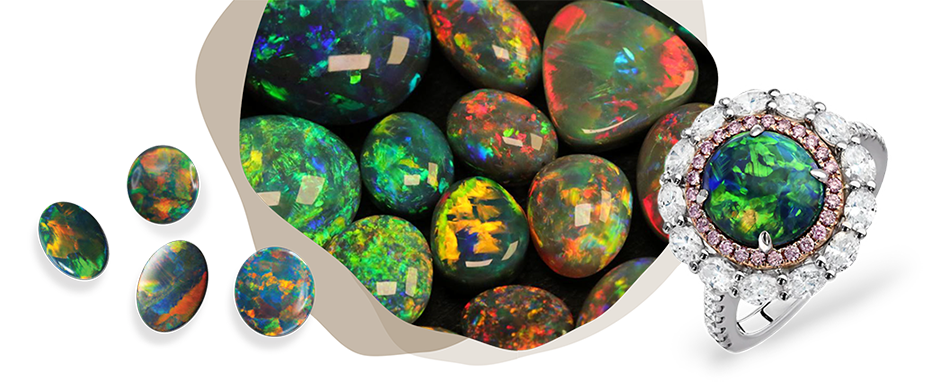Late last year I attended the first major international trade show since the COVID pandemic concluded – Jewellery and Gem World Singapore.
The atmosphere was electric. JGW Singapore welcomed just shy of 1000 exhibitors from 30 countries with more than 11,000 buyers taking part.
As a stranger in a foreign land for the first time I did what came naturally – sought out familiar faces. I scanned the directory for Australian exhibitors and tracked them down for a chat.
After pinpointing four opal jewellery exhibitors of interest, I was somewhat taken aback by what I discovered when I reached their respective stands.
They were busy – and I mean really busy!
Crowds packed in tight around their stands eager to take in the incredible array of colours displayed within these unique gemstones.
From the most prized of all - vibrant red - to velvety purples, hypnotising greens and everything in between, people peered over shoulders and patiently waited for their turn to get up close and personal with a sample.
The magnetic variety of colour capturing the attention of these passerby is caused by a unique optical phenomenon known as play-of-colour.
Australia’s opal is the cream of the crop, so it should come as no surprise that the buyers in Singapore were eager to take a look.
When I was finally able to speak with these exhibitors face-to-face they each confirmed that interest in Australian opals abroad was reaching dizzying heights.
Reflecting on my experience with Peter Sherman, a third-generation wholesaler and exporter at Sherman Opals, he says he isn’t surprised to hear of the high demand for opals at an Asian trade show.
“Australian opal is very big on the world stage right now. After a long period of COVID lockdowns, many people have quite rightfully decided that Aussie opals are the most beautiful natural gemstone,“ he tells Jeweller.
“I think many overseas consumers have learned that Australian opal is not only beautiful, it’s rare and comes in many colours and types.
“While being somewhat uniquely Australian, it’s also only found in only three states – NSW, Queensland and South Australia - which adds to the interest.”
|
 |
| L to R: Ikecho Australia; Black Opal Direct; Firegem |
|
Boulder and matrix
Australia is well-known around the world for black and white opal specimens; however, boulder and matrix opals are particularly popular.
The classification of natural opal depends on the relationship between the opal itself and the host rock in which it forms. The more well-known black and white opals are termed ‘natural type one’.
In contrast, boulder opal is ‘natural type two’, a single piece of opal that remains attached to its host rock.
Matrix opal is ‘natural type three’, in which opal snakes through pores and grains or occupies holes within the host rock.
An individual who understands the intricacies of opals well is Carl Babic of Absolute Opals, who today proudly continues a family tradition which was started by his father Marijan Babic in the 1960s.
Babic says that whether it be mining, cutting, dealing, or manufacturing, interest in the opal industry is increasing.
“I certainly believe that Australian opals are becoming more popular both overseas and within Australia,” he says.
“The emergence of the Chinese market in particular kickstarted the supply end back in 2012- 2015. The increase in demand raised prices and made the ‘hardcore’ miners want to go back to prospecting.”
"Australia's opal is the cream of the crop, so it should come as no surprise that the buyers in Singapore were eager to take a look."
Based in Lightning Ridge, George Christianos is also a third-generation opal jeweller and trader. He’s carrying on a family practice which began in Coober Pedy in the 1950s.
He explains that high-quality opals have had a vital revival internationally, beginning with demand in mainland China from around 2010, which then increased dramatically around 2015.
“The Chinese economy softened after that, but not before consumers became hooked on black opals. Since that time China has played an important role internationally as a destination for Australian opals,” Christianos details.
“In the meantime, the world has noticed the Chinese taking so much high-quality product off the market and there has been strengthened demand from traditional markets in the US and Europe.”
He added: “Truthfully, the main problem we face is insufficient and sporadic supply of high-quality opals. We can sell all that we get but we are just not getting enough.”
Challenges to overcome
The cause of this supply constraint is multi-faceted and complex.
There are a number of economic concerns, including the spiralling cost of prospecting and mining – namely fuel and machinery costs, as well as labour – that have increasingly caused headaches for those responsible for unearthing these natural beauties.
In terms of labour, there’s also a major demographic change at play. Traditional miners are ageing out of the workforce, and inexperienced young miners are entering the field and finding the financial impositions of the industry a challenge.
“Go to any bank and ask for a mortgage to buy a home. When they ask you what you do for work, tell them you’re an opal miner. They’ll laugh at you,” Christianos jokes.
The geology of the opal deposits makes them impossible to detect and assay, and producing workable calculations of an available deposit is difficult and requires tremendous experience.
Then, there’s the fact that not all opals discovered are what the market wants. Jewellers require gemstone grade-opals, with the correct colouration scarce.
“The scarcity in supply is created by a wide range of factors, it’s not as a result of any market manipulation,” he continues.
“This situation is unlikely to improve so people who understand the circumstances are buying opal inventory up, anticipating that values will keep escalating.
"The magnetic variety of colour capturing the attention of these passerby is caused by a unique optical phenomenon known as play-of-colour."
“Meanwhile several high-profile jewellery brands have made special pieces with opals as their centre stone and this has further spiked interest.”
|

|
| Black Opal Direct |
|
Fine jewellery flurry
Indeed, when it comes to jewellery a number of high-end designers and manufacturers have ramped up their involvement with opals in recent years.
Late last year Cartier’s creative director of high jewellery, Jacqueline Karachi, detailed the transformation in attitude she recently underwent concerning opal jewellery.
In an interview with the Australian Financial Review, Karachi says at the start of her career she avoided working with opals as she dismissed them as far too common.
Today, she’s embraced opals for the natural wonders that they are. This is most evident in the release of a remarkable necklace, brooch and earrings set called Apatura.
At Ikecho, new collections of rings, pendants, and necklaces which combine uniquely Australian pearls and opals have proven very popular.
Earlier this year, Artelia Jewellery creative director Maria Ulas told Jeweller that opals were always in high demand from her customers.
“We’re about to launch a collection of opal jewellery with both white and black opals of all shapes and sizes,” she said.
“As an Australian jeweller, we wanted to make something quintessentially Aussie, combining opals, sapphire and pearls to show how colourful our country uniquely is!”
Don’t underestimate the impact of marketing
A significant driving force in the rising popularity of Australian opals abroad has been the success of television shows such as Outback Opal Hunters.
Following its launch in 2018, the show has now reached a ninth season, with the series broadcast in more than 100 countries, including the UK and the US.
The premise is simple, following opal miners from a variety of backgrounds in various locations of Australia as they strive to uncover a hidden fortune.
“Trade shows and trade media always provide an important ongoing platform of support,” Babic says.
“Television shows like Outback Opal Hunters and individual online promotions on websites such as YouTube have massively contributed to education and exposure of our national gemstone both locally and globally.”
Babic points to the popularity of opal jewellery on websites such as Etsy, Facebook, and eBay in recent years as examples of the positive impact this kind of promotion has had.
Videos of opal hunters in action on YouTube routinely gather millions of views.
Sherman says that the timing of the pandemic was also an important factor in the effectiveness of this marketing.
“People had extra spare time in lockdown to scroll through and read lots of articles about our industry and that certainly contributed to their current popularity,” he explains.
“It’s hard to look past the worldwide success of the Outback Opal Hunters in particular. It’s a television series that has led to huge love for Australian opal.”
Sherman also suggests that the changing priorities of younger consumers is also an important factor.
“In this age of climate change discussion and interest in the ethics of businesses, Australian opal is an increasingly popular option for jewellery,” he says.
“People are now aware that Australian opal is ethically mined and is one of the few natural gemstones to not require extra treatment, which is a big selling point.”
Something magical?
The formation of opal is a complex curiosity and a matter that has inspired heated debate among geologists.
There have been many theories produced over the years. What is agreed upon is the necessity of certain factors for the formation of opal – silica, water, the appropriate chemical and geological conditions, and time.
Many of the major opal fields of Australia have a similar geological landscape, consisting of a thick layer of sandstone atop a layer of clay.
The most generally accepted hypothesis is known as the ‘deep weathering theory’, in which water flows through the top sandstone layer, picking up silica and continuing down through cracks and crevices to the bottom clay layer.
There, the now silica-rich solution is deposited and forms opal.
The ongoing debate around the origins of opal may suggest that these natural beauties have another intangible attraction which provokes the passion seen by miners, jewellers, and consumers alike.
John Doyle, the owner of Boulder Opal Mines Australia, says that it’s difficult to narrow down the specific reason why opal jewellery is so popular today.
|

|
| L to R: Opals by Christianos; Fortune Opal; Pink Kimberley |
|
“We are experiencing an increase in interest and sales from the international market but when it comes to answering the question of ‘why’, I’m not 100 per cent sure of the answer,” he explains.
“It could simply be because it’s a natural gemstone with a huge variety of colours, and even with a single opal you can get dramatic colour play.”
Most precious opals are found in sandstones and mudstones that developed during the Cretaceous era, 60–144 million years ago.
To date, Australia is the only place on Earth where opalised animal and plant fossils are found.
Small opalised dinosaurs and primitive mammalian remains were found at Lightning Ridge, along with prehistoric shallow marine shellfish and crustaceans.
The ancient nature of these gemstones only adds to the alluring mystery of opal jewellery.
“One important thing to understand is that opals are not enhanced in any way to improve their colours, they are just naturally gorgeous,” Doyle continues.
“Maybe, the world is starting to wake up and appreciate our Australian opal creating the strong demand we see today.”
With that said, one of the fundamental appeals of jewellery is personal storytelling. Dale Price, owner of Dale Price Opals in Coober Pedy, suggests that the biggest selling point is emotion.
“I’ve found increased demand, both within Australia and abroad,” he says.
“I think that people are looking for something to keep their spirits high. A nice piece of Australian opal does exactly that, it’s something very beautiful and quite frankly, magical.”
The story continues
Whether it’s their natural beauty, the unique and mysterious origins of their creation, the emotion they provoke, or some kind of intangible metaphysical appeal, the opal industry remains somewhat divided on what’s driving the recent of boom of international and home-grown demand.
Whatever the answer is, one thing is clear – opals and opal jewellery are enjoying a moment in the sun.
Given the recent constraints on supply and the ensuing rise in demand those market conditions tend to provoke, there’s little reason to see why the love for opals won’t continue long into the future.
Read eMag